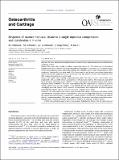| dc.contributor.author | Hufeland, M. | |
| dc.contributor.author | Schünke, M. | |
| dc.contributor.author | Grodzinsky, Alan J. | |
| dc.contributor.author | Imgenberg, J. | |
| dc.contributor.author | Kurz, Bodo | |
| dc.date.accessioned | 2014-08-21T16:05:03Z | |
| dc.date.available | 2014-08-21T16:05:03Z | |
| dc.date.issued | 2013-01 | |
| dc.date.submitted | 2012-04 | |
| dc.identifier.issn | 10634584 | |
| dc.identifier.uri | http://hdl.handle.net/1721.1/88952 | |
| dc.description.abstract | Objective:
To study mechanical overload of mature meniscal tissue under normal and pro-inflammatory conditions in vitro.
Method:
Three days after a single unconfined compression (strain: 25–75%, strain rate 1/s) of meniscal explants from 16 to 24 months-old cattle combined with interleukin-1-treatment (IL-1, 10 ng/ml) release of glycosaminoglycans (GAGs; dimethylmethylene blue (DMMB) assay), lactate dehydrogenase (LDH; cytotoxicity detection kit), and nitric oxide (NO; Griess assay), as well as gene transcription (quantitative reverse transcription polymerase chain reaction (RT-PCR)) and numbers of cells with condensed nuclei (CN; histomorphometry) were determined.
Results:
Mean peak stresses during compression were about five (25%), 11 (50%), and 30 MPa (75%), respectively. GAG and LDH release and numbers of CN increased whereas NO production and mRNA levels of matrix metalloproteinase (MMP)-2, -3 and a disintegrin and metalloproteinase with thrombospondin motifs (ADAMTS)-4 decreased strain-dependently after compression. IL-1 induced an increase in GAG and NO release as well as MMP-2, -3 and ADAMTS-4 levels, but had no impact on the LDH release and slightly increased numbers of CN. However, in combination with compression the tissue responses were reduced and LDH and CN levels were increased compared to IL-1 alone.
Conclusion:
Our data suggest that a single impact compression induces cell damage and release of GAG and reduces the NO production and transcription of certain matrix-degrading enzymes. It also reduces the capacity of meniscal tissue to respond to IL-1, which might be related to the cell damage and suggests that the compression-related GAG release might rather be the result of immediate extracellular matrix-damage than a cell-mediated event. This, however, needs to be confirmed in future studies. | en_US |
| dc.description.sponsorship | ENDO-Stiftung (Hamburg, Germany) | en_US |
| dc.description.sponsorship | ENDO-Klinik (Hamburg, Germany) | en_US |
| dc.language.iso | en_US | |
| dc.publisher | Elsevier B.V. | en_US |
| dc.relation.isversionof | http://dx.doi.org/10.1016/j.joca.2012.10.003 | en_US |
| dc.rights | Article is made available in accordance with the publisher's policy and may be subject to US copyright law. Please refer to the publisher's site for terms of use. | en_US |
| dc.source | Elsevier Open Archive | en_US |
| dc.title | Response of mature meniscal tissue to a single injurious compression and interleukin-1 in vitro | en_US |
| dc.type | Article | en_US |
| dc.identifier.citation | Hufeland, M., M. Schünke, A.J. Grodzinsky, J. Imgenberg, and B. Kurz. “Response of Mature Meniscal Tissue to a Single Injurious Compression and Interleukin-1 in Vitro.” Osteoarthritis and Cartilage 21, no. 1 (January 2013): 209–216. © 2013 Elsevier B.V. | en_US |
| dc.contributor.department | Massachusetts Institute of Technology. Department of Biological Engineering | en_US |
| dc.contributor.mitauthor | Grodzinsky, Alan J. | en_US |
| dc.relation.journal | Osteoarthritis and Cartilage | en_US |
| dc.eprint.version | Final published version | en_US |
| dc.type.uri | http://purl.org/eprint/type/JournalArticle | en_US |
| eprint.status | http://purl.org/eprint/status/PeerReviewed | en_US |
| dspace.orderedauthors | Hufeland, M.; Schünke, M.; Grodzinsky, A.J.; Imgenberg, J.; Kurz, B. | en_US |
| dc.identifier.orcid | https://orcid.org/0000-0002-4942-3456 | |
| mit.license | PUBLISHER_POLICY | en_US |
| mit.metadata.status | Complete | |
